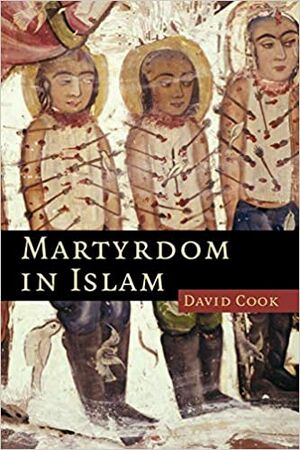Martyrdom in Islam
The book Martyrdom in Islam, is a very informative book which reveals many ancient Islamic documents discussing the theology of martyrdom.
 | |
| Author | David Cook |
|---|---|
| Language | English |
| Published | 2007 |
| Publisher | Cambridge University Press |
| Pages | 244 |
About the author[edit | edit source]
David Cook is Assistant Professor in Religious Studies at Rice University. His publications include Studies in Muslim Apocalyptic (2002), Understanding Jihad (2005), and Contemporary Muslim Apocalyptic Literature (2005).
About the book[edit | edit source]
This book published in Cambridge University Press (January 15, 2007), has 224 pages and best sellers rank of 2,481,399 in Books.
The author in this book, reviews the hadith and numerous other ancient Muslim tracts that analyzed how Allah might approve of a warrior's death in a martyrdom event. Most of the book extensively reviews the historical development of Islamic martyrdom theology during the Middle Ages.
Abstract of chapters[edit | edit source]
Chapter 1: Martyrs in religions[edit | edit source]
In this chapter the writer begins his study with brief discussions of martyrdom in Judaism and Christianity. He introduces some martyrs and the stories of their martyrdoms: the portrayals of the enemy, the nature of the audience participation and subsequent commitment expected from it, and the form of the martyrdom narrative, which is the method of eternalizing the act and its pathos.
Chapter 2: Martyrdom in the genesis of Islam[edit | edit source]
In this chapter Cook turns to the life of the prophet Muhammad. He deals with the specific commonalities of Islamic martyrdom and categorizes the types of martyrs based on their beliefs and the reasons for which they martyred.
Chapter 3: Legal definitions, boundaries and rewards of the martyr[edit | edit source]
This part provides one of the most direct proofs that there is a special place prepared for martyrs, or at least for those killed in jihad, because for the most part the Quran does not single out martyrs. It also considers the conditions of martyrdom in men and women according to verses and hadiths.
Chapter 4: Sectarian Islam: Sunni, Shiite and Sufi martyrdom[edit | edit source]
This chapter is about sectarianism. Although the Shiite legal material does not differ significantly from the Sunni discussions on martyrdom, the writer has mentioned different groups of martyrs (Sunni, Shiite and Sufi martyrdom) and examined them and their manners. As a conclusion, where Sunnism lacks martyrs, however, Shiism has a rich martyrdom history, they have contributed more than any other single group in Islam towards martyrology, and probably the most unusual forms of martyrdom within an Islamic context are those Sufi martyrs, who were so overwhelmed with love for God and humanity that they were willing and, in some cases, even anxious to demonstrate that love through death.
Chapter 5: Martyrs: warriors and missionaries in medieval Islam[edit | edit source]
In this section, the author gives examples of martyrs from every region of the world such as India, Central Asia, Anatolia and Southeast Europe, Indonesia and Malaysia, and west and east Africa by mentioning their stories.
Chapter 6: Martyrs of love and epic heroes[edit | edit source]
This chapter deals with the well-known tradition about dying of lovesickness. According to the writer, the source of martyrs of love is the malady of lovesickness, which unlike in contemporary usage, really was a sickness (at least according to the historical and medical sources). When a lover first beheld his beloved, the former was invariably stricken to the core with desire that when unmet had physical effects. This desire was so deep that it would literally cause sickness and ultimately death. The other type of martyrs are Epic heroes (literary and political martyrs). There is a whole class of martyrs that are non-religious but occasionally acquire religious significance after their deaths. Some of these were literary in nature, while others have historical reality to them but are gradually transformed into literary figures.
Chapter 7: Patterns of prognostication, narrative and expiation[edit | edit source]
In this chapter there is an element of expiation inside the process of fighting and dying in jihad that is explored in detail.
Chapter 8: Martyrdom in contemporary radical Islam[edit | edit source]
Cook in this chapter notes that not until the rise of radical Islam, which is focused on the jihad, have Sunnis started to produce martyrologies in large numbers. Throughout the 1990s and beyond, radical Muslims have fought their governments and tried to set up Muslim regimes in place of what they consider to be apostate and illegitimate governments. The most painful difficulty associated with radical Islam is its theory of martyrdom. the course that radical Islam has taken over the past thirty years has proven that radical Muslims really prefer to kill each other. Through the use of suicide attacks, the rise in Muslim deaths has been exponential and, in many cases, the Muslims who have carried out these attacks have been glorified in some place, or by some Muslim group as actual martyrs.
Chapter 9 Martyrdom in Islam: past and present[edit | edit source]
This chapter shows that martyrdom in Islam is in general not a passive action the part of the believer, but more of an active action in which the martyr seeks out the circumstances that will lead to his or her own martyrdom so, the dominant themes is the close relationship between martyrdom and jihad, rather than between martyrdom and missions.